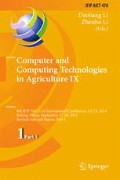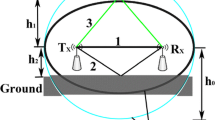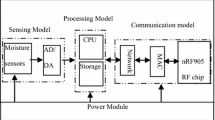Abstract
In order to realize the deployment of wireless sensor network in large areas of plastic greenhouses. The propagation characteristics of radio wave in plastic greenhouse were studied. The Received Signal Strength Index (RSSI) in greenhouse and between greenhouses were studied, and the logarithmic path loss model for RSSI was established. The results show that the radio wave attenuation parameters A and n between greenhouses were 30.785 and 2.89. The attenuation index was larger than the index of free space. In the plastic greenhouse planted with tomatoes, the radio wave attenuation parameters A and n in the ground were 34.99 and 3.64, and in the top of canopy were 35.14 and 2.85, its show that the radio wave transmission has been significantly affected by the crop in the plastic greenhouse.
You have full access to this open access chapter, Download conference paper PDF
Similar content being viewed by others
Keywords
1 Introduction
As a new method for information acquiring and processing, wireless sensor network technology was applied in agricultural environmental monitoring and controlling [1, 2]. In WSNs, it’s characterized by realization the transmission of signals by radio waves, while radio waves will be affected by the surrounding environment in the transmission process [3]. So radio propagation is affected by the barrier of crops in the agriculture environment. Therefore, propagation characteristics of wireless channel in agricultural environment has attracted considerable attention, and the research in the propagation characteristics of wireless channel in the typical agricultural environment such as wheat [4–6], apple [7, 8], citrus [9], durian [10] and plum [11] was conducted.
In recent years, as an important content of modern agricultural development, the protected agriculture has developed rapidly, and China has become the largest area country of the protected agriculture. At present, the protected agriculture is developing to the direction of standardization, automation, intelligence and network [12]. The related research has been conducted in the aspect of wireless measurement and control of the greenhouse environment [13–19]. The plastic greenhouse is mainly used for insulation of autumn winter and early spring to realize cultivation in the early spring and late-autumn, which is widely distributed in the south area of china. In the plastic greenhouse, the transmission of radio waves are affected by planting environment and coverings, for the complex environment, so the plastic greenhouse is the typical application environment with obstacles.
In this paper, the plastic greenhouse as the research object, research of propagation characteristics of radio waves between and in plastic greenhouse were study in order to provide basis for the layout of wireless sensor network in the large-scale plastic greenhouse groups.
2 Experiments and Methods
2.1 The Experiment Test Systems
The experiment test systems were shown in Fig. 1, which mainly consisted of receive and send node, USB debugging simulator, PC (Personal Computer), data packet analysis software Packet Sniffer, tripod and tape, etc.
The function of receive and send node was to receive and send radio signals, and the sensor node CC2430 was used as receive and send node. During the testing, the receive node was attached to PC through USB debugging simulator, fixed to the starting point, while the send node moved in sequence according to test points in the direction of test. Radio signals were extracted and analyzed through protocol analyzer software Packet Sniffer. The tripod provided the supporting point in order to keep the receive and send node at the same height, and the tape was used to measure the distance between the receive node and send node.
2.2 Experimental Method
The test place was located in the vegetable planting center of Garden Village, Danyang city Jiangsu province, and linked plastic greenhouse with the same specification were chosen as the experimental subjects, of which the length and width were respectively 70 m and 7.6 m, and the distance between the two sheds was 1.7 m while the distance between the two separated by the road was 12 m; The test of propagation characteristics of radio waves on the crop canopy were respectively conducted between and in the plastic greenhouse.
2.2.1 Experiments Between the Plastic Greenhouse
In order to test the effects of propagation characteristics of radio waves. In plastic greenhouse, this paper designed the experimental scheme as shown in Fig. 2. The plastic greenhouse were numbered, and the left ones were the odd-numbered while the right were the even-numbered. When testing, the receive node was fixed at the plastic greenhouse NO. 1, and the antenna height was 1 m on the ground, and the node was attached to PC computer through USB debugging simulator, and it received signal strength and the number of packet dropout through software, The send node was fixed at the tripod, and the antenna height was also 1 m, which moved respectively in the odd-numbered and even-numbered plastic greenhouse, experiments were divided into 2 groups as shown in the following figure, and 3 test points were set in each plastic greenhouse. And the distance between receive and send node was obtained through calculation after testing.
2.2.2 Experiments in the Plastic Greenhouse
Tomatoes planting in the plastic greenhouse were chosen as the experimental subjects, which was in the fruiting period, and the average canopy height was 80 cm while the average row spacing was 60 cm.
In order to analyze the optimum deployment location for nodes, two groups of tests were conducted located in the ground and canopy and the height from the antenna height was 90 cm when the nodes were located in the canopy. During testing, the receive node was fixed at the starting point, while the sender moved in sequence in the middle of the row until there were no signals.
2.3 Test Parameters
(1) Received Signal Strength Index (RSSI)
RSSI (Received Signal Strength Index) was used to judge the link quality, and in this experiments, the protocol analyzer software Packet Sniffer was used for extraction of signals.
(2) Path loss
Path loss is the difference power between effective send radiations and received, which presents attenuation degree of signals, a positive value in dB. The study results [4] show that path loss conform to logarithm path loss model, which can be expressed as:
P r is the average intensity of received signals, A is a parameter of regression analysis model, which presents the effect of application environment on the attenuation of the intensity of radio signals, d is transmission distance of signals; n is attenuation index, which presents decay rate of signal intensity.
3 Results and Discussion
3.1 Propagation Characteristics of Radio Waves Between the Plastic Greenhouses
3.1.1 Effect on Intensity of Received Signals
The RSSI changing with the different distance between receive and send node when radio waves transmitted between the plastic greenhouses was shown as Fig. 3.
In the figure, effective propagation path of the two groups of tests was the same, and signal strength of the receive node tended to digression with the increasing distance between the receive and send node, and the strength of received signals decreased sharply when the distance between the receive and send node is smaller while the strength of received signals decreased gently when the distance between the receive and send node increased.
The change of the test 1 and test 2 was the same, and signal strength of both test has the jumping phenomenon, and the data of test 2 was fluctuated obviously. For electromagnetic wave transmitting between the plastic greenhouse is a process of the combination of transmission and reflection, the penetrating power of electromagnetic wave was depended on electric characteristic of the substance, and the insulator will allow electromagnetic wave through with smaller loss, while the good conductor will block the most of radio waves, which accelerated the attenuation of electromagnetic wave. Although the surface of the plastic greenhouse is a layer of plastic with good insulation, the difference of humidity of each plastic greenhouse would change electromagnetic characteristics of the plastic, which leads to the difference of transmission loss in each greenhouse. On the another hand, the reflection of electromagnetic wave can lead to interference phenomenon in which field strength was promoted or down, which will aggravate the jumping phenomenon of the signal strength of electromagnetic wave in short distance. So the combined effect of transmission and reflection leads to fluctuation of signal strength of individual test point in test 1 and test 2.
3.1.2 Result Analysis
A regression analysis was conducted of the value of tested RSSI between the plastic greenhouse in the path loss model by using the least square method, the value of the parameters A and n was obtained as shown in Table 1. The table showed that the relative coefficients R 2 of the test 1 and 2 were 0.943 and 0 916, which means it was reasonable to describe and predict the propagation characteristics between the plastic greenhouse using log-path loss model. The value of parameters of the two groups of tests were basically the same, and the difference of A and were respectively 1.25 and 0.054, which means the propagation characteristics of radio waves was the same in both cases.
3.2 Propagation Characteristics of Radio Waves in the Plastic Greenhouse
3.2.1 Effect on the Strength of Received Signals
The RSSI changing with the distance between the receive and send node in the plastic greenhouse was shown as in Fig. 4. The results showed that the strength of received signals both in the ground and canopy were decreased with the increasing distance between the receive and send node. The strength of received signals decreased sharply when the distance between the receive and send node was shorter, and the decay rate in the ground was sharper than in the canopy. When the strength of received signals declined to about −83 dBm, the transmission distance was 15 m in the ground and 39 m in the canopy. With the increasing distance of the receive and send node, the decay rate of the received signals in the ground and canopy tended to be gentle, and the transmission distance was 15 m in the ground and 39 m in the canopy. The transmission distance in the canopy was obviously longer than that in the ground, and the distance that could be tested was only 30 m in the ground.
3.2.2 Result Analysis
A regression analysis was conducted of the value of tested RSSI of tomatoes by using the least square method, and the value of the parameters A and n was obtained as shown in Table 2.
The results showed that the relative coefficients R 2 in the ground and canopy were respectively 0.9699 and 0.9091, which means it was reasonable to describe and predict the propagation characteristics of tomatoes using log-path loss model. Attenuation index n in the ground was greater than that in the canopy, and the difference between the two location was 0.79, which meant decay rate of radio waves of sensor nodes located in the ground were better than that in the canopy. For the lower location of the tape when the sensor nodes were in the ground, the transmission of the radio waves were affected by leaves of tomatoes greatly, which made attenuation index increased. That also meant the location of nodes in crops decided the attenuation index of radio waves and was related to the transmission distance of sensor nodes.
4 Conclusions
This paper analyzed propagation characteristics of 2.4 GHz radio waves between and in the plastic greenhouse, and conclusions were as follows:
-
(1)
Propagation characteristics of radio waves between the plastic greenhouse conformed to log-path loss model, and the relative coefficients were respectively 0.943 and 0.916. The average value of decay parameters between the plastic greenhouse of A and n were 30.785 and 2.89, and decay index n was greater than that of free-space, which was caused by transmission loss of radio waves.
-
(2)
Propagation characteristics of radio waves in the plastic greenhouse for cultivation of tomatoes conformed to log-path loss model, and the relative coefficients in the ground and canopy were respectively 0.9699 and 0.9091. Decay rate of radio waves was slower when sensor nodes located in the canopy. The sensor nodes should be deployed in the tomato canopy or above of it when the wireless sensor network was deployed in tomatoes.
References
Ning, W., Naiqian, Z., Maohao, W.: Wireless sensors in agriculture and food industry—Recent development and future perspective. Comput. Electron. Agric. 50, 1–14 (2006)
Wei, Y., Minzan, L., Xiu, W.: Status quo and progress of data transmission and communication technology in field information acquisition. Trans. CSAE 24(5), 297–301 (2008)
Yick, J., Mukherjee, B., Ghosal, D.: Wireless sensor network survey. Comput. Netw. 52(12), 2292–2330 (2008)
Liu, H., Wang, M., Zhijun, M., et al.: Performance assessment of short-range radio propagation in crop fields. J. Jiangsu Univ. (Natural Science Edition) 31(1), 1–5 (2010)
Siyu, L., Hongju, G., Jianzhao, J.: Impact of antenna height on propagation characteristics of 2.4 GHz wireless channel in wheat fields. Trans. CSAE 25(2), 184–189 (2009)
Zhen, L., Tiansheng, H., Wang, N., et al.: Path-loss prediction for radio frequency signal of wireless sensor network in field based on artificial neural network. Trans. CSAE 26(12), 178–181 (2010)
Andrade-Sanchez, P., Pierce, F.J., Elliott, T.V.: Performance assessment of wireless sensor networks in agricultural settings. ASABE (2007). Paper No. 073076
Xiuming, G., Chunjiang, Z., Xinting, Y., et al.: Propagation characteristics of 2.4 GHz wireless channel at different heights in apple orchard. Trans. CSAE 28(12), 195–200 (2012)
Tao, W., Tiansheng, H., Zhen, L., et al.: Test of wireless sensor network radio frequency signal propagation based on different node deployments in citrus orchards. Trans. CSAE 26(6), 211–215 (2010)
Phaebua, K., Suwalak, R., Phongcharoenpanich, C., et al.: statistical characteristic measurements of propagation in durian orchard for sensor network at 5.8 GHz, communications and information technologies. In: International Symposium on IEEE, ISCIT 2008, pp. 520–523 (2008)
Vougioukas, S., Anastassiu, H.T., Regen, C., et al.: Influence of foliage on radio path losses (PLs) for wireless sensor network (WSN) planning in orchards. Biosyst. Eng. 114(4), 454–465 (2012)
Pingping, L., Jizhang, W.: Research progress of intelligent management for greenhouse environment information. Trans. Chin. Soc. Agric. Mach. 45(4), 236–243 (2014)
Zhongfu, S., Hongtai, C., Hongliang, L., et al.: GPRS and WEB based data acquisition system for greenhouse environment. Trans. CSAE 22(6), 131–134 (2006)
Song, Y., Ma, J., Zhang, X., et al.: Design of wireless sensor network-based greenhouse environment monitoring and automatic control system. J. Netw. 7(5), 838–844 (2012)
Park, D.H., Kang, B.J., Cho, K.R., et al.: A study on greenhouse automatic control system based on wireless sensor network. Wirel. Pers. Commun. 56(1), 117–130 (2011)
Park, D.H., Park, J.W.: Wireless sensor network-based greenhouse environment monitoring and automatic control system for dew condensation prevention. Sensors 11(4), 3640–3651 (2011)
Li, L., Gang, L.: Design of greenhouse environment monitoring and controlling system based on Bluetooth technology. Trans. Chin. Soc. Agric. Mach. 37(6), 97–100 (2006)
Li, X., Cheng, X., Yan, K., et al.: A monitoring system for vegetable greenhouses based on a wireless sensor network. Sensors 10(10), 8963–8980 (2010)
Ping, S., Yangyang, G., Pingping, L.: Intelligent measurement and control system of facility agriculture based on ZigBee and 3G. Trans. Chin. Soc. Agric. Mach. 43(12), 229–233 (2012)
Acknowledgment
Funds for this research was provided by the prospective research Foundation of Jiangsu province (BY2013065-07), the fund of Jiangsu University (14JDG188) the Priority Academic Program Development of Jiangsu Higher Education Institutions.
Author information
Authors and Affiliations
Corresponding author
Editor information
Editors and Affiliations
Rights and permissions
Copyright information
© 2016 IFIP International Federation for Information Processing
About this paper
Cite this paper
Wang, J., Peng, Y., Li, P. (2016). Propagation Characteristics of Radio Wave in Plastic Greenhouse. In: Li, D., Li, Z. (eds) Computer and Computing Technologies in Agriculture IX. CCTA 2015. IFIP Advances in Information and Communication Technology, vol 478. Springer, Cham. https://doi.org/10.1007/978-3-319-48357-3_20
Download citation
DOI: https://doi.org/10.1007/978-3-319-48357-3_20
Published:
Publisher Name: Springer, Cham
Print ISBN: 978-3-319-48356-6
Online ISBN: 978-3-319-48357-3
eBook Packages: Computer ScienceComputer Science (R0)








